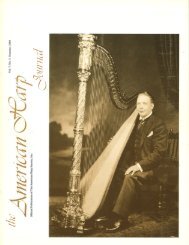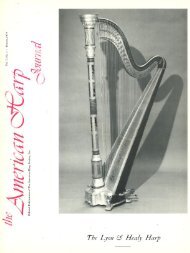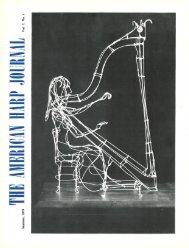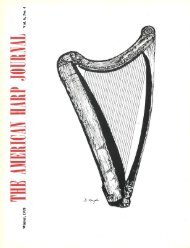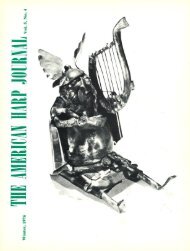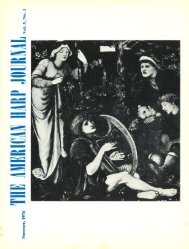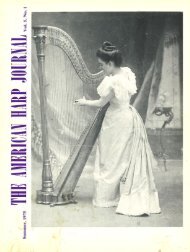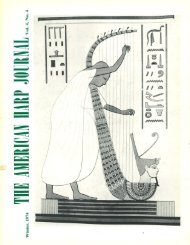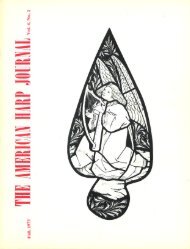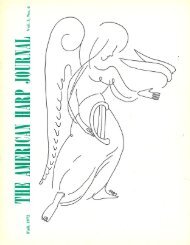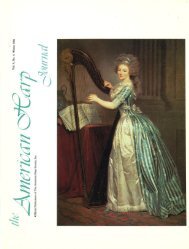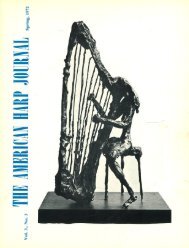Create successful ePaper yourself
Turn your PDF publications into a flip-book with our unique Google optimized e-Paper software.
the role of dux, while the role of comes is divided<br />
between Trebles I and III. At the third entrance (m.<br />
30), as one might expect, Treble I functions as dux<br />
and the role of comes is divided between Trebles II<br />
and III. Britten directs that the final unison note held<br />
by the chorus should be made increasingly louder, as<br />
a preparation for the succeeding piece.<br />
"This Little Babe"<br />
"This Little Babe" begins in E-flat minor (Aeolian<br />
mode), the parallel minor key of the preceding work<br />
in E-flat major. The initial theme, sung in unison<br />
(mm. 4- 17), functions perfectly as a melody on its<br />
own. It is destined, however, for canonic treatment at<br />
the unison at the close time interval of a quarter note<br />
in two parts (mm. 20- 33), and in three parts (mm.<br />
36- 50). Because of the close time interval, the effect<br />
of stretto is achieved.<br />
The chorus joins forces for a fortissimo homophonic<br />
section to the text "My soul, with Christ join thou in<br />
fight." The harmony (mm. 51-61) alternates between<br />
E-flat minor and its dominant, B-flat major;<br />
thus, the strength of the words is supported by the<br />
strongest possible harmonic progression.<br />
The climax of the piece brings back the opening<br />
theme in augmentation, continued ever upward to a<br />
cadence in E-flat major. The rhythmic interest in this<br />
final section is created by the use of hemiola over<br />
each two-measure unit. A real excitement is generated<br />
when choral parts and harp accompaniment<br />
enter into a non-simultaneous duple feeling against<br />
the ~ time signature.<br />
"Interlude"<br />
In the "Interlude," the placement and character of<br />
which remind one of the "Pastoral Symphony" of<br />
Handel's Messiah, Britten offers evidence of consummate<br />
craftsmanship. The entire plainchant of the<br />
"Procession" (minus part of the Alleluias) is paraphrased<br />
in the treble of the harp solo over an ostinato<br />
pattern marked by a descending fifth. The notation of<br />
the entire plainchant defies the usual laws of notation<br />
for 1 ; meter.<br />
It is obviously the composer's intention that quadruple<br />
pulsation is to be avoided and that the plainchant<br />
paraphrase should float freely above the ostinato,<br />
thus retaining the character of plainsong. A<br />
further contribution to the floating sensation of this<br />
piece is made by the scoring of the ostinato figure in<br />
harmonics, a special ethereal effect of which only the<br />
harp is truly capable.<br />
Modality and tonality are judiciously mixed. The<br />
opening four measures are in the Aeolian mode on<br />
A-flat. The ostinato then descends on a full step so<br />
that the Mixolydian mode on G-flat is heard in the<br />
following three measures. The bass figure descends<br />
Patricia Pence - Sokoloff<br />
instruction<br />
m<br />
harp<br />
Bachelor of Music/Bachelor of Arts<br />
Major in Harp<br />
Electives in Harp<br />
Majors in Arts Management<br />
Electives in Arts Management<br />
Salem College<br />
SCHOOL OF MUSIC<br />
Winston - Salem, <strong>No</strong>rth Carolina 27108<br />
A distinguished school of music for 100 years<br />
<strong>Winter</strong>/<strong>1980</strong> 29




